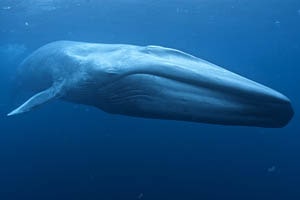English Documentary on Blue Whales with Transcript to practice listening and vocabulary with illustrated flashcards and a podcast for TOEFL & IELTS candidates
Source of documentary: National Geographic YouTube Channel
Size of blue whales
Blue Whales are the largest animals to have ever existed. As long as about three school buses and as heavy as 15, blue whales even outsized the dinosaurs.
The whales marine habitat contributes to their exceptional size. The ocean provides more room to grow and eliminates one of the factors that usually hinder animal size, gravity. Gravity limits the size of land animals to what their skeletons can support. The oceans buoyancy spares marine mammals of this limitation, thereby allowing them to grow unlike any other animal.
Sounds made by blue whales
Blue whales have one of the loudest calls in animal kingdom. Measuring up to 188 decibels, their song can be loud enough to overpower the sounds of jackhammers and jet engines. The whales use their powerful songs to communicate with each other, oftentimes from long distances. These vocalizations, which are deep moans and rhythmic low frequency pulses, have been recorded from over 500 miles away.
Lifespan of blue whales
A blue whale’s age can be determined by its earwax. About every six months, a new layer of earwax forms inside a whale’s ear canal. The wax primarily serves to protect the ear canal and helps carry sound waves into the whale’s inner ear. However this buildup of wax layers called an ear plug, can be measured and used to estimate a whale’s age much like counting the rings in a tree trunk.
The average lifespan of a blue whale is about 80 to 90 years, but the oldest one found based on its waxy ear plug count was about one hundred and ten years old.
Blue whales’ diet
Blue whales can eat four tons of food a day, that`s more than an African elephant weighs. Despite the whales’ enormous size, their diet primarily consists of tiny crustaceans called krill. The whales use their pouch like lower jaws to scoop up swarms of thousands of krill floating in the water.
The whales then push the water out of their mouths and through baleen bristles lining their upper jaws. The bristles are thin enough to let water through but thick enough to catch krill.
Whale baleen
Whale baleen was often used in 19th century fashion. Inaccurately referred to as whale bone, whale baleen is instead made of keratin, the same strong flexible material found in fingernails. Keratin allowed baleen to become an ideal material for structuring clothes, such as corsets, collars, hat brims and hooped frames in skirts.
Once endangered species
Because of the high commercial value of baleen and other whale body parts, blue whales were nearly exterminated. Today, thankfully global bans on whaling were put in place allowing the species to slowly rebound.




I’ve always loved animals. We humans consider ourselves the best of creations, but we’ve always made life hard for other species or even our own kind. I sometimes think about how much healthier our planet would be if we’ve never existed; By the way, whale with that size is such a cute and extraordinary creature.
Compared to their massive size, blue whales are so harmless and calm. It’s so surprising for me that these aquatic marine or aquatic beasts don’t have gills. So, they have to reach the surface of even the deepest waters to breathe in and inhale an abundance of oxygen.
Nature always surprised us. Extraordinary animals beyond our expectations intermingled with myths and superstitions over centuries. Whales are one of those creatures. They were considered both as monsters of oceans and rescuers of some people. Most of the facts mentioned in this documentary surprised me, e.g. how we can estimate the age of blue whales, the huge amount of their diet per day, and the loudness of their sound. All of these make my belief stronger that how nature chose the most developed, powerful, and adaptable creatures through millions of years.
Almost like the other documentaries we’ve transcribed so far, this one on blue whales, too, has been awe-inspiring to me. Blue whales belong to one of the most ancient mammals that have ever roamed on this planet. I’ve always found them mysterious and kind, not so much about killer whales, though.
Whales to me, are one of the most astonishing animals that have ever existed. They are enormous but they seem to be so calm and with no trouble. Studies have shown that whales’ sounds can be even calming and relaxing as well.
I totally agree with you on whales being so calm and fabulous. I also like their sounds and find them incredibly soothing.
Blue Whales are the largest animal to have ever excited as long as about three school buses and as heavy as 15 blue whales even outsized the dinosaurs. The whales marine habitat contribute to their exceptional size. The ocean provides more room to grow and eliminate one of the factors that usually hinder animal size. Gravity limits the size of land animals to what their skeletons can support. The oceans buoyancy spares marine mammals of this limitation, thereby allowing them to grow unlike any other animal.
Blue whales have one of the loudest calls on animal kingdom. Measuring up to 188 decibels their song can be loud enough to overpower the sounds of jackhammers and jet engines. The whales use their powerful songs to communicate with each other, oftentimes from long distances. These vocalizations which are deep moans and rhythmic low frequency pulses have been recorded from over 500 miles away. A blue whales age can be determined by its earwax. About every six months, a new layer of earwax forms inside a whale’s ear canal. The wax primarily serves to protect the ear canal and helps carry sound waves into the whale inner ear. However this buildup of wax layers called an ear plug, can be measured and used to estimate a whale aged much like counting the rings in tree trunk. The average life span of a blue whale is about 80 to 90 years, but the oldest one found based on its waxy ear plug count was about one hundred and ten years old.
Blue whales can eat four tons of food a day, that`s more than an African elephant weighs. Despite the whales enormous size, the diet primarily consists of tiny crustaceans’ called krill. The whales use their pouch like lower jaws to scoop up swarms of 1000 of krill floating in the water. The whales then push the water out of their mouth and through baleen bristles lining their upper jaws, the bristles are thin enough to let water through but thick enough to catch krill.
Whale baleen was often used in 19th century fashion. Inaccurately referred to as whale bone, whale baleen is instead made of keratin the same strong flexible material found in fingernails. Keratin allowed baleen to become an ideal material for structuring clothes such as corsets, collars, hat brims and hooped frames in skirts.
Because of the high commercial value of baleen and other whale body parts, blue whales were nearly exterminated. Today, thankfully global bans on whaling were put in place allowing the species to slowly rebound.
Thank you so much indeed for your efforts. There were few mistakes detected in your transcription, and you can trace them by comparing your work as a comment here and the body of this post.